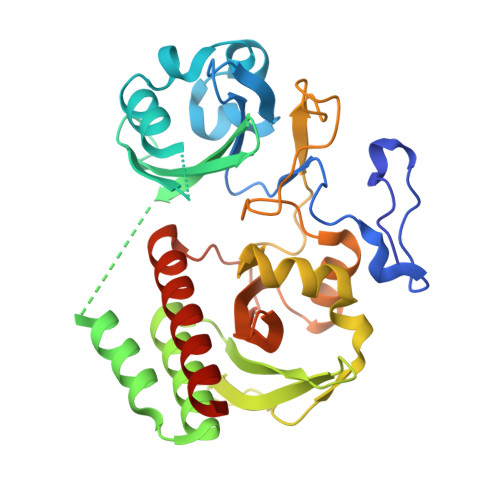Structural Determinants of Improved Fluorescence in a Family of Bacteriophytochrome-Based Infrared Fluorescent Proteins: Insights from Continuum Electrostatic Calculations and Molecular Dynamics Simulations.
Feliks, M., Lafaye, C., Shu, X., Royant, A., Field, M.(2016) Biochemistry 55: 4263
- PubMed: 27471775
- DOI: https://doi.org/10.1021/acs.biochem.6b00295
- Primary Citation of Related Structures:
5AJG - PubMed Abstract:
Using X-ray crystallography, continuum electrostatic calculations, and molecular dynamics simulations, we have studied the structure, protonation behavior, and dynamics of the biliverdin chromophore and its molecular environment in a series of genetically engineered infrared fluorescent proteins (IFPs) based on the chromophore-binding domain of the Deinococcus radiodurans bacteriophytochrome. Our study suggests that the experimentally observed enhancement of fluorescent properties results from the improved rigidity and planarity of the biliverdin chromophore, in particular of the first two pyrrole rings neighboring the covalent linkage to the protein. We propose that the increases in the levels of both motion and bending of the chromophore out of planarity favor the decrease in fluorescence. The chromophore-binding pocket in some of the studied proteins, in particular the weakly fluorescent parent protein, is shown to be readily accessible to water molecules from the solvent. These waters entering the chromophore region form hydrogen bond networks that affect the otherwise planar conformation of the first three rings of the chromophore. On the basis of our simulations, the enhancement of fluorescence in IFPs can be achieved either by reducing the mobility of water molecules in the vicinity of the chromophore or by limiting the interactions of the nearby protein residues with the chromophore. Finally, simulations performed at both low and neutral pH values highlight differences in the dynamics of the chromophore and shed light on the mechanism of fluorescence loss at low pH.
Organizational Affiliation:
Université Grenoble Alpes , Institut de Biologie Structurale (IBS), F-38044 Grenoble, France.















